I found some good photos and a great web-site and put together this post for my WWII German Aviation collection. The Junkers Ju-88 Night-fighter was possibly the most successful variant of the aircraft.
Originally shared by Pete Panozzo
JUNKERS JU-88 NIGHTFIGHTER
Development
[This profile covers the fighter and attack variants of the Junkers Ju 88, bomber and reconnaissance variants will be covered separately.]
By the middle of 1944, the night fighter force had become the strongest and most efficient arm of the Luftwaffe, comprising almost fifteen per cent of its first line strength. From May 1940 onwards, the appearance of ever increasing numbers of RAF bombers at night over Germany had forced the Luftwaffe to set up a powerful night air defence organisation which soon became involved in a bitter see-saw battle for supremacy in the night sky. The Junkers Ju 88 night-fighter was a key weapon in this crucial battle. From 1944 until the end of the war, Ju 88s equipped the vast majority of Nachtjagd units, and constant development of the airframe and of numerous electronic aids maintained its reputation as a formidable fighting machine until the very end.
The Junkers Ju 88 first arose from a German Air Ministry requirement for a dedicated high-speed medium bomber. In a calculated move, Junkers temporarily recruited two engineers from America to help design the new aircraft. W.H. Evers and Alfred Grossner applied their considerable expertise in modern aircraft structural design to produce in the Ju 88 a remarkably efficient and adaptable design. The first prototype (D-AQEN) flew on 21 December 1936, and subsequent testing of additional prototypes confirmed its excellent performance. A production order followed and Luftwaffe service testing commenced early in 1939.
The performance of the prototype had generated early interest in adapting the type for other roles, and one of the first roles considered was that of Zerstörer (heavy-fighter). The Luftwaffe concept of a twin-engined high-speed long-range day fighter was widely shared by other European air forces at the time. Accordingly, in early summer 1939, Junkers modified the Ju 88 V7 prototype to include a forward-firing armament of two 20 mm MG FF cannon and two 7.9 mm MG 17 machine-guns located in a modified nose section partially covered by metal plates. The underfuselage gondola was also removed and the crew reduced to three. Powered by two 1,200 hp Junkers Jumo 211B-1 engines, the unmodified Ju 88 V7 had first flown on 27 September 1938, and was soon back in the air testing the new armament. The new fighter offered a maximum speed similar to that of the much smaller Messerschmitt Bf 110, but with three times the range, and the type was ordered into limited production.
A small batch of early production Ju 88A-1 bombers were converted into Ju 88C-0s during July and August 1939, and used operationally during the invasion of Poland by the Zerstörerstaffel of KG 30 for long-range ground-attack. It was initially planned that the subsequent production variants would be the the Ju 88C-1 with 1,600 hp BMW 801MA air-cooled radials, and the Ju 88C-2 with liquid-cooled 1,200 hp Jumo 211B-1 engines behind annular radiators. In the event, the BMW 801 engines were reserved for the new Focke-Wulf Fw 190 fighter and the C-1 and the proposed C-3 derivative were abandoned. The first production model was thus the C-2 with an armament of one 20 mm MG FF cannon and three 7.9 mm MG 17 machine-guns in a new smooth metal nose section. These aircraft were converted on the production line, and retained the ventral gondola. The C-2s were used for more than a year for coastal and anti-shipping patrol, before another role appeared.
From May 1940, the RAF began to attack Germany regularly by night and it was quickly realised that anti-aircraft guns alone would not be able to defend Germany adequately. Accordingly, the Zerstörerstaffel of KG 30 was reinforced with additional Ju 88C-2s and redesignated II/NJG 1 in July, joining the newly established night-fighter force under General Kammhuber. The Gruppe specialised in conducting night intruder operations – hunting RAF bombers over British aerodromes identified by radio intercepts. On 11 September 1940, the Gruppe was redesignated I/NJG 2. The small number of intruder aircraft available was hopelessly inadequate to counter the ever increasing threat from Bomber Command, and the perceived lack of results led to Hitler ordering the end of further intruder operations on 12 October 1941. I/NJG 2 was soon transferred to Sicily for intruder operations over Malta and the Mediterranean.
In the mean time, a new Zerstörer variant had been developed, the Ju 88C-4. This was similar to the C-2, but used the improved airframe of the Ju 88A-4, featuring increased overall wing span from 60 ft 3¼ in (18.37 m) to 65 ft 7½ in (20.0 m) and a sturdier undercarriage. Other improvements included more armour protection for the crew and an extra 7.9 mm MG 15 machine-gun in the rear of the offset ventral gondola. The Junkers Jumo 211B-2 powered C-4 was the first C-series model produced as new-build and not by conversion. Production numbers of the C-4 remained relatively low compared to the bomber variants. A modified version, the Ju 88C-6 was operated by V/KG40 from September 1942 to counter RAF Coastal Command operations against U-boats in the Bay of Biscay. Later the Gruppe was absorbed into ZG 1 but disbanded in June 1944. Other C-6s were used for train-busting on the Russian Front in 1943.
Early in 1942, the new FuG 212 Lichtenstein C-1 radar was experimentally fitted to four of NJG 1s Ju 88C night-fighters. The cumbersome ‘stags antlers’ aerial array reduced maximum speed by 15-25 mph and so the reaction of crews was initially unfavourable, until a number of kills were scored using it. The introduction of radar on the Ju 88C-6 resulted in a designation change to Ju 88C-6b, while existing day-fighter aircraft were retrospectively redesignated Ju 88C-6a. The initial radar fit was the FuG 202 Lichtenstein BC, but by the Autumn of 1942 this had been replaced by the simplified FuG 212 Lichtenstein C-1. In a parallel development, the Ju 88R-series of night fighters differed from the Ju 88C-6b mainly in having BMW 801 engines.
The ‘Himmelbett’ defensive system of ground controllers directing night-fighters to within visual range of a their targets was now well established, and the introduction of radar made the last phase of an intercept much easier. Previously quite scarce in the Nachtjagd (most Ju 88Cs were still in the Mediterranean), the Ju 88 now began to equip an increasing number of night-fighter units. Night-fighters were meant to keep to their assigned control sector, but when it was found that a narrow bomber stream would saturate the relatively thin ‘Kammhuber line’ of defensive sectors, a more free-ranging ‘Zahme Sau’ technique – whereby some night-fighters would join and follow bomber stream – was introduced. The long-range Ju 88C-6b and Ju 88R-1 were particularly suited to this role, and began to equip many units. A major set-back for the night-fighters was the use of ‘Window’ jamming by the RAF, first introduced on 24/25 July 1943. This rendered existing ground and airborne radars useless, and it wasn’t until October 1943 that the Ju 88C-6c appeared with a FuG 220 Lichtenstein SN-2 radar which operated on a different frequency. In the meantime, ‘Zahme Sau’ tactics dominated, with night-fighters using FuG 227 Flensburg which homed-in on Allied bomber ‘Monica’ tail-warning radars. By April 1944, the Ju 88C-6c equipped almost the entire Nachtjagd.
In the Summer of 1942, the war on the Russian Front had meanwhile highlighted a need for dedicated ground-attack/tank-buster aircraft. Among the possible solutions was a Ju 88C-4 experimentally fitted with a Nebelwerfer recoilless rocket launcher. This weapon reassembled a six-barrelled gatling gun and the modified aircraft was unofficially known as the Ju 88N or Ju 88Nbwe. Trials of this weapon were soon abandoned in favour of the Ju 88P series. The Ju 88P V1 was a modified Ju 88A-4, with a large belly fairing housing a 75 mm KwK 39 cannon firing forward and two MG 81Z machine-guns at the rear. Trials were relatively successful and a small number of Ju 88P-1 production aircraft were ordered. The Ju 88P-1 featured a Ju 88C solid nose, armour protection for the engines and a 75 mm PaK 40L cannon with a big muzzle brake. The type was issued to a few units in 1943 for operational testing, but proved very unwieldy and vulnerable to enemy fighters. Effectiveness was reduced by the gun’s slow rate of fire. Two further versions, the Ju 88P-2 with two 37 mm BK 3.7 Fak 18 canon and the Ju 88P-3 with increased armour protection were only completed in small numbers. The final tank-buster variant was the Ju 88P-4 with a single 50 mm Bk 5 cannon in a much smaller belly fairing. All four variants saw active service on the Eastern Front in 1944. Some were used as train-busters, while a small number of P-2s were tried as night-fighters and day interceptors against USAAF bomber formations – proving to be completely unsuitable.
The introduction of increasingly heavier armament, more armour, and a radar operator had a detrimental affect on the low-speed handling qualities of the overburdened Ju 88C series, and it was becoming apparent that the development of a specialised Ju 88 night-fighter model was now necessary to restore lost performance and safe handling. In 1943, a Ju 88R-2 was experimentally fitted with the enlarged squared-off tail unit of the Ju 188, becoming the Ju 88 V58. A completely revised armament fit was introduced. Two MG 151/20 cannon were housed in the right-hand side of the nose, and four more located in a ventral tray under the left side of the belly. Designated Ju 88G V1, the new version first flew in June 1943 and served as the prototype for a new series of night-fighters. The Ju 88G-0 pre-production aircraft differed from the prototype in deleting the nose mounted MG 151 cannon, as they blinded the pilot at night. The increased power of the 1,700 hp BMW 801D radials helped restore much of the type’s good handling qualities. The Ju 88G-1 was the first series production version, essentially the same as the G-0. The new model rapidly replaced the Ju 88C from the middle of 1944, many with FuG 227 Flensburg which homed in on British ‘Monica’ tail warning radar. The next production version was the Ju 88G-6a, similar to the G-1 but with two 1,700 hp BMW 801G engines. The Ju 88G-6b carried the FuG 350 Naxos Z radio equipment which homed-in on bomber H2S blind-bombing radar emissions, larger fuel tanks and two MG 151/20 cannon in a ‘Schräge Musik’ installation firing obliquely upwards and forwards from the upper fuselage – usually at an angle of 70 degrees. The pilot simply formated under the bomber and fired upwards in an easy zero-deflection shot.
The final production G series model was the Ju 88G-7, powered by two Jumo 213E engines with MW-50 power boosting to 1,800 hp on take-off. The Ju 88G-7a had FuG 220 Lichtenstein SN-2 radar, while the Ju 88G-7b had FuG 218 Neptune V radar with either the standard ‘toasting fork’ aerials or a Morgenstern array enclosed in a pointed wooden nose cone. The G-7c had FuG 240 Berlin N-1 centimetric radar with the scanner enclosed in a plywood nose cone. Only ten G-7c were completed, before the end of the war.
In the last few months of the war, a number of G-1 airframes were converted to act as the warhead portion of the Mistel flying bomb. Pilotless missile steered by the fighter mounted on top. A Focke-Wulf Fw 190 was mounted above the Ju 88 to guide it towards the target, before releasing at the last moment. Some isolated successes were scored in attacking bridges.
Immediately after the end of the war, Allied intelligence teams rapidly moved into Germany to secure examples of all the latest aircraft. A significant number of Ju 88G series aircraft were brought back to France, Britain and the USA for thorough evaluation. All of these machines were later scrapped. It does not appear that any example of the Ju 88G reached the Soviet union.
Derived from undoubtedly the most versatile German combat aircraft of WW2, the Ju 88 night-fighter was a refined and formidable aircraft, with a powerful armament, excellent agility and advanced electronic sensors. It is therefore appropriate that Ju 88 night-fighters destroyed more Allied night bombers in WW2 than all other fighters combined.
http://www.aeroflight.co.uk/tag/junkers
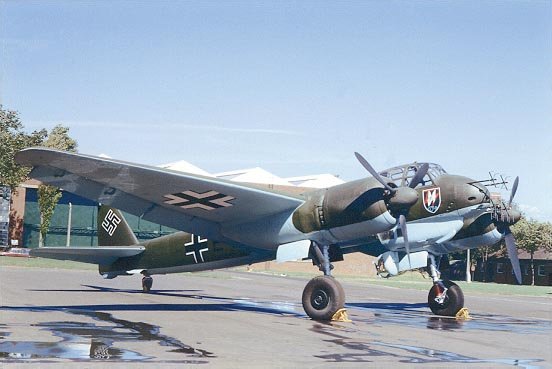
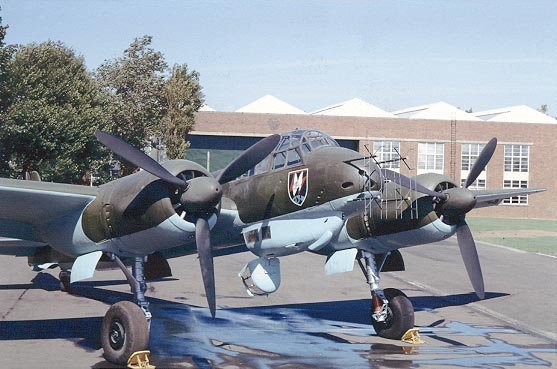

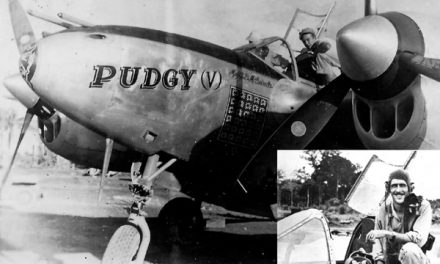
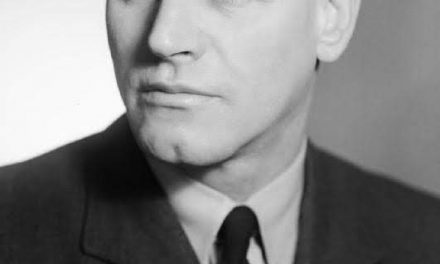

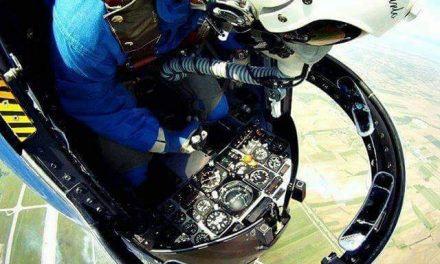
Recent Comments